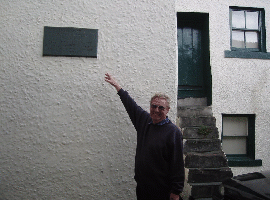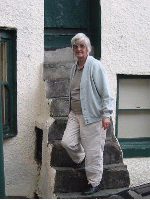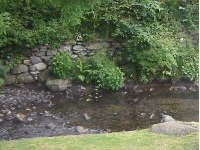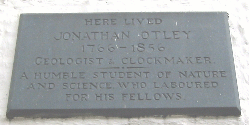| Jonathan Otley | by © |
 These pages are the result of a visit on Tuesday 8 July, 2003, and on work shared by
These pages are the result of a visit on Tuesday 8 July, 2003, and on work shared by

Jonathan Otley 1766-1856, watch and clock repairer, geologist, surveyor, map maker, biologist, studied Grasmere, Keswick and surrounding areas. Jonathan was born at Scroggs House, which has it's own page. His father traced his ancestors back to 1662 in the St Oswald's Grasmere register.
|
 In 1979 we came with the 3 children, descendants of Jonathan's sister Jane Otley, to learn about their 5 greats Uncle Jonathan. They enjoyed his display in the museum at Keswick, and the 500 year old cat in a trunk.
In 1979 we came with the 3 children, descendants of Jonathan's sister Jane Otley, to learn about their 5 greats Uncle Jonathan. They enjoyed his display in the museum at Keswick, and the 500 year old cat in a trunk.25 years after our first visit, Max and I returned. To our surprise there is one exhibit which is aging backwards - the 500 Year Old Cat is still only 500 years old!
Jonathan Otley was recognised as the Keswick Watchmaker. He was the local expert on geology, constructed the first maps of the area. He corresponded as an equal with many scientists of the period 1810 to 1850, including Mr Dalton the world-famed chemist from 1812 and Professor Adam Sedgwick of Trinity College, Cambridge, who was a long time friend, shared his last day and prayed with him.
His memory is kept alive in Keswick Museum, as a careful scientist knowing the meteorology, botany and geology of the district, but shy because he had a stutter. We visited the Keswick museum, where there is a display of some of Jonathan's relics, including the Surveying Instruments used by him, his Guide Books in 8 editions from 1837 to 1850, and this map. |
| Some of his friends and neighbours
Jonathan Otley 1766 - 1856 hiked and wrote about his ideas. In 1825 he desribed Ennerdale's Pillar Rock as unclimbable as the peak could not be reached by walking - so sparking a competition won by John Atkinson in 1826. Poet Robert Southey owned a musical box, and Jonathan added an inscribed plate 'Repaired by Jonathan Otley 1818'. This box later went to South Africa with a member of the Southey family. He lived at Greta Hall and was known for the large number of books he owned. John Dalton 1766 - 1844 shared his interest in the Lake District (and named Jonathan as one of the executors of his Will). They worked together to determine the composition of gas from the floating island at Derwentwater and Jonathan published his findings in 1819. The Astronomer Royal, Sir George Airey came to the 'Lakes' to see and converse with him. William Wordsworth 7 Apr 1770 - 1850 who was born at Cockermouth, lived at Rydal from 1813 and is buried at Grasmere with his sister Dorothy, wife Mary and 3 children. Samuel Taylor Colridge in August 1802 made a nine-day hike from Keswick around the district including a climb to the top of Scafell. Sir John Richardson 1787 - 1865, the distinguished Arctic explorer, is buried near the Lych Gate at St Oswalds Grasmere The railway line from Kendal to the new town Windermere was planned in 1847, built from Penrith to Cockermouth in 1856 but is now closed. |
|
In 1791 Jonathan came to Keswick aged 25, and found lodgings at the Toll Bar House at Brow Top. This house had just been converted from a farm cottage at 'Skinnerscales', and the road joining Ambleside Rd with Penrith Rd, had just been completed. The tollhouse previous to the one at Brow Top was opposite Murray Lodge in Dr Harrow's garden, and was taken down about 1880. Mr Dawson gave him board and lodging at 5/- a week, and a small window facing the coach road to display his wares and his sign 'Jonathan Otley, Clockmaker and Engraver'
Households obtained their water from wells and the water was not suspected as a source of the epidemics in the area. His microscope and chemicals to determine the purity of the water from the various wells and middens in use resulted in him advocating a public water supply by pipes to the town - an asset brought to fruition in his old age.
|
|
Jonathan attended a Bible Class run by James Stanger, the restorer of Crosthwaite Church, and most Sundays attended church there. His seat was next to the pillar and there is only room for one person. His name appears in the old book recording vestry meetings, with his signature as having attended. Jonathan and his apprentice repaired the old clock at Crosthwaite Church, and recorded on the pendulum case- A public subscription was entered into in the autumn of 1841 for the purpose of repairing the clock which has been out of repair for upwards of half a century. |
| In 1853, and aged 87 years, Jonathan found he was having difficulty climbing the steps to his work room and office, so he decided to retire, and sold by auction his books, tools and instruments, gaining him 20 pounds. He rented a small cottage next to Miss Pettitt's shop in St John St, and his neice (Jane Wilson) came to keep house for him. Aged 90, on 7th December 1857, in the late afternoon, Jonathan died - news received with grief by his friends the townsfolk. |
|
1957 was the centenary of Jonathan's death, and "The Keswick Reminder" published an account of his life by Tom Wilson. Tom's last line reads - 'It is a hundred years since Jonathan died, and it would be a fitting gesture to his memory to place a little stone tablet on the steps in Kings Head Yard.' |

 The location of Jonathan's shop is now called Kings Head Court, and is part of the show rooms of John Young Antiques.
The steps have been retained, but the door is sealed, and the interior refurbished. I posed, pretending I have visited Uncle.
The location of Jonathan's shop is now called Kings Head Court, and is part of the show rooms of John Young Antiques.
The steps have been retained, but the door is sealed, and the interior refurbished. I posed, pretending I have visited Uncle.
Jonathan Otley 19 Jan 1766 - 7 Dec 1856, brother of Jane, geologist, map maker, watch mender, meteorologist who invented a rain gauge, and correspondent with the notable scientists of his times, has a memorial plaque near the site of his shop known as 'Jonathan up the steps'.
|
| by © 4 x great neice |


 After over 5 years, Jonathan moved into Keswick and closer to his clients.
Jonathan obtained lodgings in Kings Head Yard at 6/- per week with John Robson, and rented a room next door for 1/- a week, which he retained for 56 years.
After over 5 years, Jonathan moved into Keswick and closer to his clients.
Jonathan obtained lodgings in Kings Head Yard at 6/- per week with John Robson, and rented a room next door for 1/- a week, which he retained for 56 years.
 It reads:
It reads: